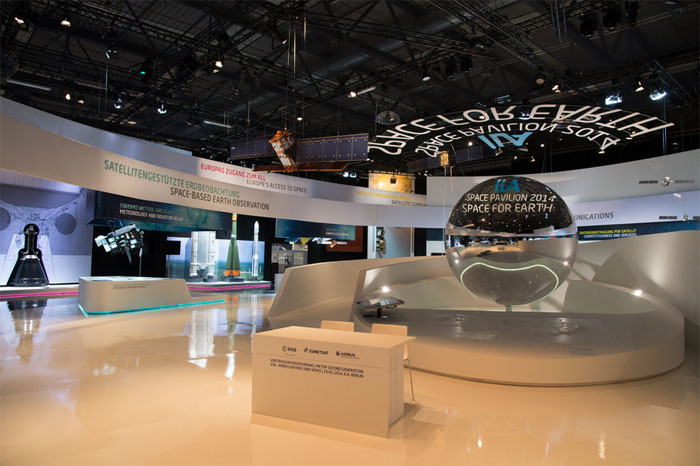.

Entrance of the ‘Space for Earth’ space pavilion at ILA, the Berlin Air and Space Show, on 20 May 2014.
A full-size model of Alphasat, the largest and most sophisticated telecom satellite ever built in Europe, sits in front of the pavilion. The first mission to use the Alphabus platform was launched atop an Ariane 5 in July 2013.
.

The ‘Space for Earth’ space pavilion at ILA, the Berlin Air and Space Show, on 20 May 2014.
This year, when ESA and its member states are celebrating 50 years of European Cooperation in Space, the exhibition underlines the importance of building on the past achievements on space science, exploration and applications to shape the future of Europe in this strategic sector.
.

Angela Merkel visits the ‘Space for Earth’ space pavilion at ILA
Jean-Jacques Dordain, ESA Director General, presents to the German Chancellor Angela Merkel and to Charles Bolden, NASA Administrator, the ‘Space for Earth’ space pavilion at ILA, the Berlin Air and Space Show, on 20 May 2014.
.

Panel discussion on Future Challenges for Global Space Cooperation at the ‘Space for Earth’ space pavilion at ILA, the Berlin Air and Space Show, on 20 May 2014.
From left to right: Jean-Jacques Dordain, ESA’s Director General, Charles Bolden, NASA Administrator, Johann-Dietrich Wörner, Chairman of the Executive Board of DLR, Evert Dudok, Head of Airbus Defence and Space – Communication, Intelligence and Security and Ulrich Bobinger, moderator.
.

Charles Bolden, NASA Administrator, and Jean-Jacques Dordain, ESA Director General, take part in a panel discussion on Future Challenges for Global Space CooperationPanel discussion on Future Challenges for Global Space Cooperation at the ‘Space for Earth’ space pavilion at ILA, the Berlin Air and Space Show, on 20 May 2014.
.

The ‘Space for Earth’ space pavilion at ILA, the Berlin Air and Space Show, on 20 May 2014.
Quelle: ESA
.
Earth observation programmes and their benefits for the environment, society and Europe’s economy will take centre-stage at next week’s ILA Berlin Air Show.
The Director of ESA’s Earth Observation Programmes, Volker Liebig, will open the panel discussion with a presentation on ESA’s activities.
Space-based Earth observation is a priority for Europe – a densely populated, highly industrialised continent.
In response to the need for information to understand and manage our environment, a strong scientific community and high public awareness of environmental protection, resource planning, climate change and disaster management have emerged.
For four decades, European satellites have delivered high-quality data from space, triggering major discoveries and providing concrete evidence of phenomena such as of the evolution of the ozone hole and climate change.
Many aspects of Earth’s physics are still a mystery, making scientific projects crucial to better understanding of our world.
With the launch of the first Sentinel satellite developed for Europe’s Copernicus environment monitoring programme, remote sensing from space has entered a new era.
As an initiative headed by the European Commission in partnership with ESA, Copernicus uses accurate and timely data from satellites and other sources to provide key information services to improve the way the environment is managed, help mitigate the effects of climate change, enable the creation of new applications and services for citizens and businesses, and safeguard everyday lives.
The presentation on Europe’s Earth observation activities is scheduled for 11:00–12:00 CEST (10:00–11:00 GMT) on 22 May, during the Trade Visitor days, inside the conference area of the ILA Space Pavilion.
Representatives from ESA will join colleagues from the DLR German Aerospace Center, Eumetsat, Airbus Defence & Space, the University of Jena, European Commission and the European Maritime Safety Agency to discuss the multiple benefits of satellite Earth observation.
The panel will present scientific results, as well as the expected applications of future Earth observation missions.
Quelle: ESA
6291 Views
